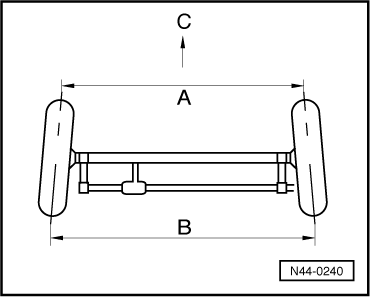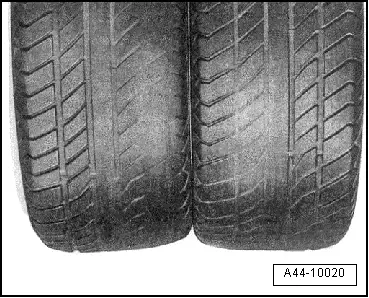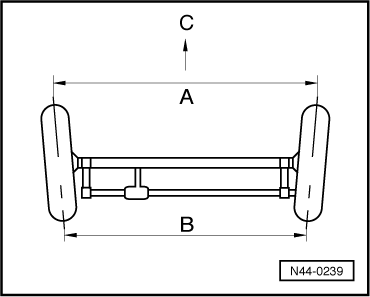| The distance between the wheels is lower at the front -A- in relation to distance -B- behind (-C- direction of travel). |
| To avoid unilateral tyre wear, observe that the position of
the wheels remains within tolerance values indicated by the vehicle's
manufacturer. The most frequent wheel alignment deviation is due to
external causes. For example, hitting the wheel on the curb extremely
hard during a parking maneuver. |
| While measuring the axle geometry, it may be determined whether
the position of the wheel is within the tolerance values indicated
or it may be necessary to carry out a correction. |
| If „lowering kits“ and/or light alloy wheels
not recommended by Volkswagen are used, the position of the wheels
may diverge from the position indicated by the factory. |
| Even if the adjustment of the axle geometry appears to be
correct when measured on the stationary vehicle, altering the height
and position of the wheels with the vehicle in motion may modify the
suspension's moving patterns. |
| Irregular wear will be the following consequence: |
| Using Off-road - Level adjustment is only recommended for
all terrain driving. Permanently using Off-road - Level adjustment
in normal driving conditions on the road may cause great tyre wear,
because the height change modifies the position of the wheels in relation
to the floor level. |
| To prevent unilateral tyre damage, on one side,
the correct axle geometry adjustment must be ensured, while on the
other side the vehicle must be used appropriately. |
| Good maintenance of vehicle and tyres contributes to prevent
wear. The following indications must be observed for that purpose: |
| t
| The minimal tyre calibration pressure must be observed. |
| t
| Depending on driving style, different wear in front and rear
axles may not be avoidable. To counter this effect, the wheels may
be rotated regularly. It is also useful to replace the summer tyres
with winter tyres, and vice versa. This replacement has as a positive
result an even wear on all tyres, making the assembly of a complete
set of new tyres possible. This avoids the use of tyres with different
tread designs on both axles, and the results may be negative on behaviour
of the vehicle in motion. |
| t
| The wear in shape of saw consists in a normal wear especially
in the very calm driving mode → Chapter. This
fact can cause a higher rolling noise (in the tread), but it usually
owners again, as the reduction of depth grooves occurs. If the existence
of a wear in the shape of saw is still incipient or it is still being
built-up, the wheel's rotation on the axles is generally enough
to resist to this effect. In case of unusual wear in shape of saw,
the wheels shall be rotated in accordance → Chapter, so as to change its tread direction. |
| t
| Some designs on the tyre tread suggest visually an anticipated
wear when the ribs on the winter tyres or the incisions on the surface
got worn, remaining only the compact blocks without empty areas, which
give an idea of wear on the tyre. In this case, it is required to
measure the remaining depth of the tyre tread remaining portion in
each tyre's groove. If this depth is higher than the minimum
depth required by law (1.6 mm; it is recommended in Germany the use
of winter tyres with a remaining depth of 4 mm, and only under weather
conditions typical of summer [law imposition in Austria], the tyre
can continue to be used without reservation. |
|
|

|





